Report on Employee Relations: Conflict Resolution and HR Strategies
VerifiedAdded on 2020/01/23
|25
|4054
|88
Report
AI Summary
This report delves into the multifaceted aspects of employee relations, analyzing conflicts from unitarist and pluralist perspectives. It examines the impact of trade unions and the crucial role of HR in fostering a healthy working environment. The report explores various conflict resolution procedures, evaluating their effectiveness, and offers insights into industrial disputes and actions. It also highlights key features of the employee-employer relationship, emphasizing communication, consultation, and grievance procedures. The report provides a comprehensive overview of maintaining positive employee relations, emphasizing the importance of HR strategies and management approaches to create a harmonious and productive workplace.
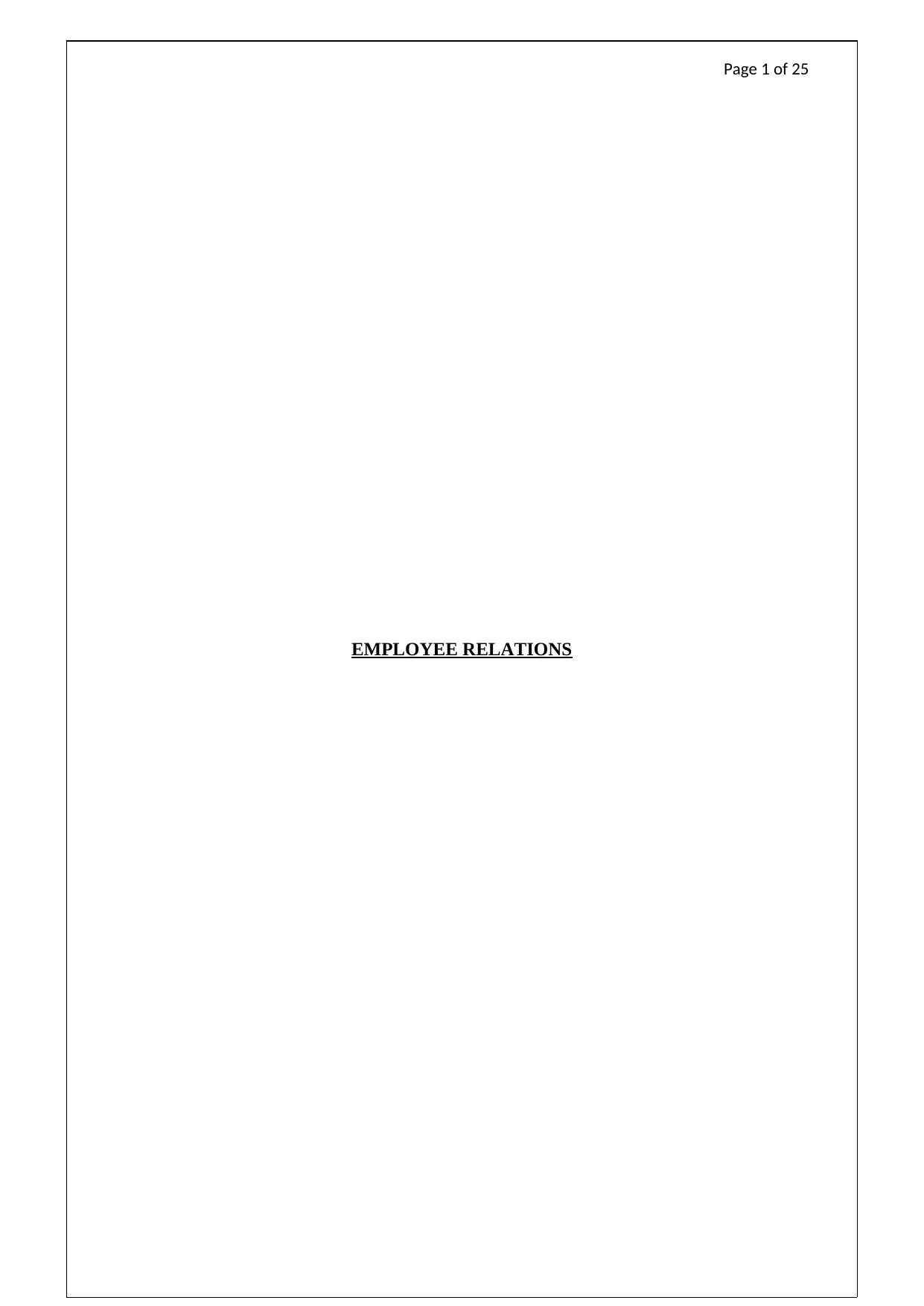
Page 1 of 25
EMPLOYEE RELATIONS
EMPLOYEE RELATIONS
Paraphrase This Document
Need a fresh take? Get an instant paraphrase of this document with our AI Paraphraser
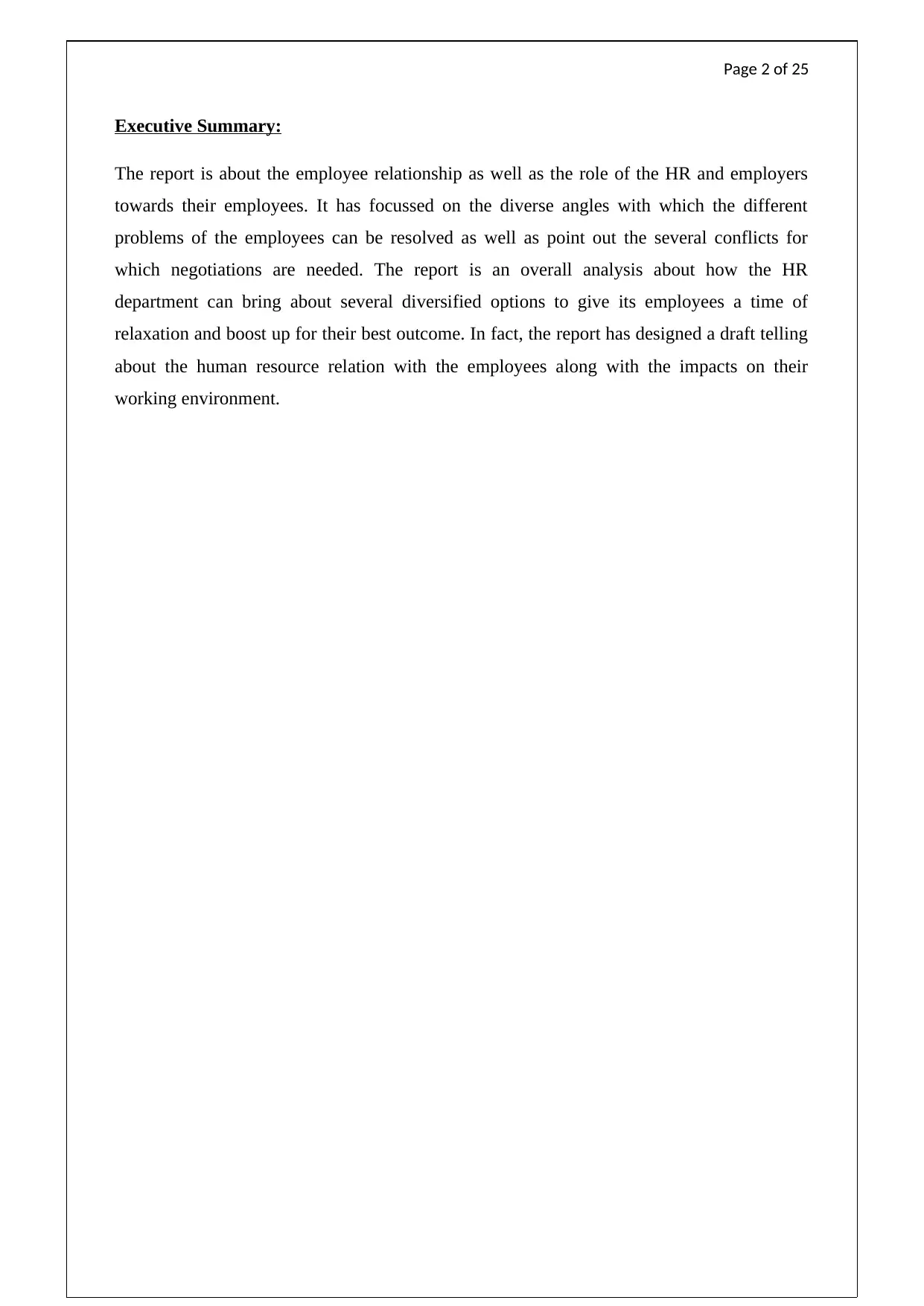
Page 2 of 25
Executive Summary:
The report is about the employee relationship as well as the role of the HR and employers
towards their employees. It has focussed on the diverse angles with which the different
problems of the employees can be resolved as well as point out the several conflicts for
which negotiations are needed. The report is an overall analysis about how the HR
department can bring about several diversified options to give its employees a time of
relaxation and boost up for their best outcome. In fact, the report has designed a draft telling
about the human resource relation with the employees along with the impacts on their
working environment.
Executive Summary:
The report is about the employee relationship as well as the role of the HR and employers
towards their employees. It has focussed on the diverse angles with which the different
problems of the employees can be resolved as well as point out the several conflicts for
which negotiations are needed. The report is an overall analysis about how the HR
department can bring about several diversified options to give its employees a time of
relaxation and boost up for their best outcome. In fact, the report has designed a draft telling
about the human resource relation with the employees along with the impacts on their
working environment.
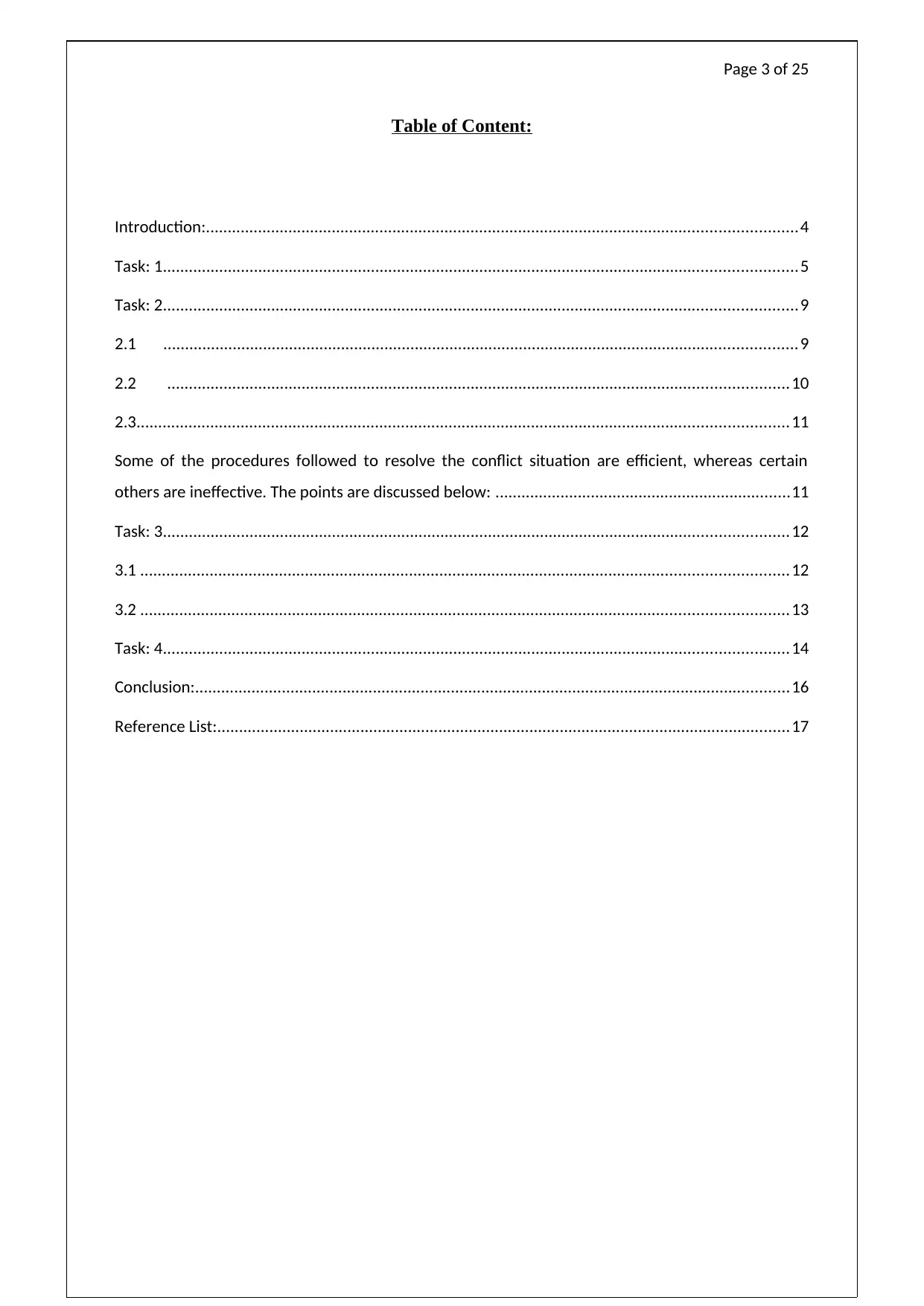
Page 3 of 25
Table of Content:
Introduction:........................................................................................................................................4
Task: 1..................................................................................................................................................5
Task: 2..................................................................................................................................................9
2.1 ..................................................................................................................................................9
2.2 ...............................................................................................................................................10
2.3......................................................................................................................................................11
Some of the procedures followed to resolve the conflict situation are efficient, whereas certain
others are ineffective. The points are discussed below: ....................................................................11
Task: 3................................................................................................................................................12
3.1 .....................................................................................................................................................12
3.2 .....................................................................................................................................................13
Task: 4................................................................................................................................................14
Conclusion:.........................................................................................................................................16
Reference List:....................................................................................................................................17
Table of Content:
Introduction:........................................................................................................................................4
Task: 1..................................................................................................................................................5
Task: 2..................................................................................................................................................9
2.1 ..................................................................................................................................................9
2.2 ...............................................................................................................................................10
2.3......................................................................................................................................................11
Some of the procedures followed to resolve the conflict situation are efficient, whereas certain
others are ineffective. The points are discussed below: ....................................................................11
Task: 3................................................................................................................................................12
3.1 .....................................................................................................................................................12
3.2 .....................................................................................................................................................13
Task: 4................................................................................................................................................14
Conclusion:.........................................................................................................................................16
Reference List:....................................................................................................................................17
⊘ This is a preview!⊘
Do you want full access?
Subscribe today to unlock all pages.

Trusted by 1+ million students worldwide
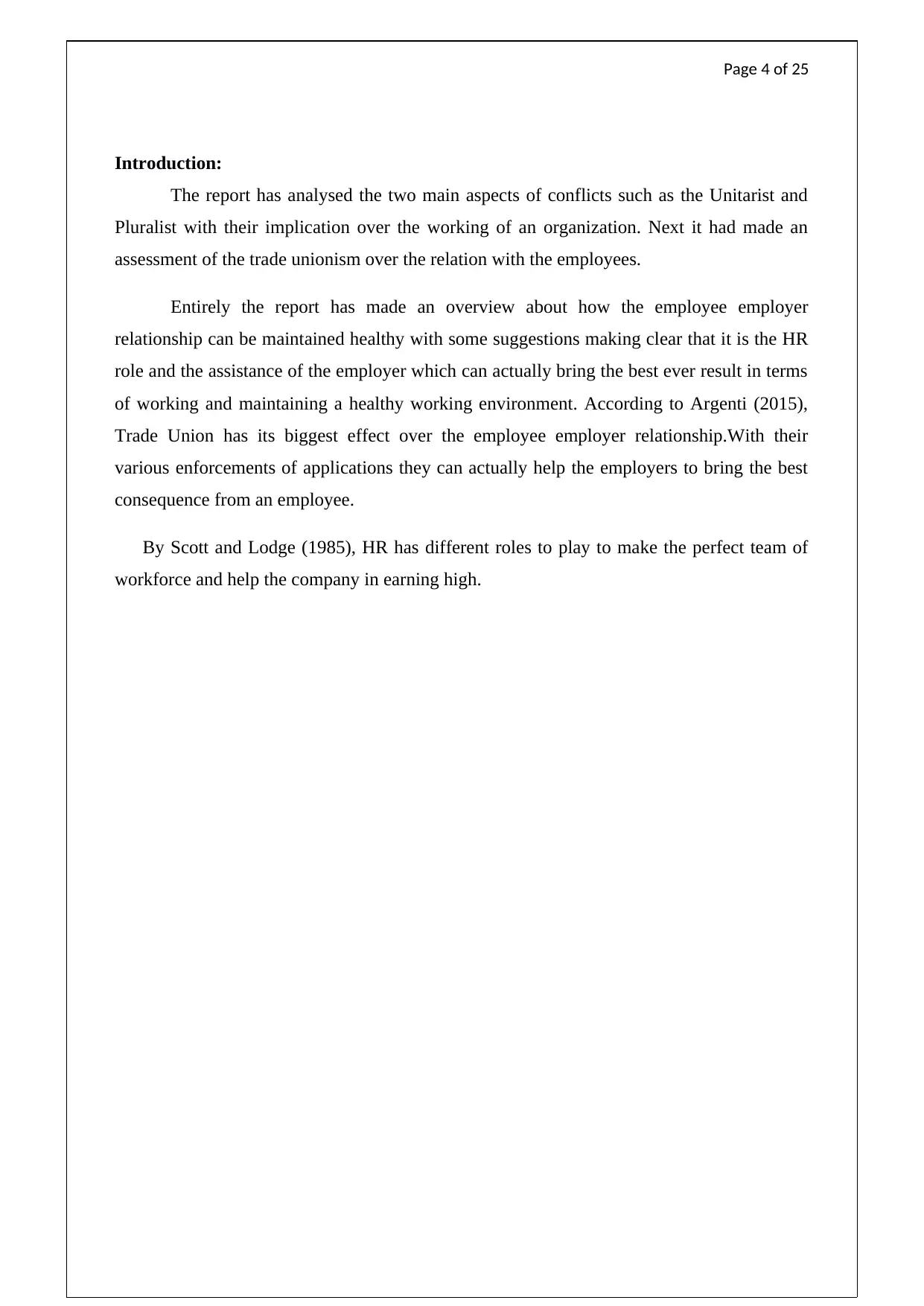
Page 4 of 25
Introduction:
The report has analysed the two main aspects of conflicts such as the Unitarist and
Pluralist with their implication over the working of an organization. Next it had made an
assessment of the trade unionism over the relation with the employees.
Entirely the report has made an overview about how the employee employer
relationship can be maintained healthy with some suggestions making clear that it is the HR
role and the assistance of the employer which can actually bring the best ever result in terms
of working and maintaining a healthy working environment. According to Argenti (2015),
Trade Union has its biggest effect over the employee employer relationship.With their
various enforcements of applications they can actually help the employers to bring the best
consequence from an employee.
By Scott and Lodge (1985), HR has different roles to play to make the perfect team of
workforce and help the company in earning high.
Introduction:
The report has analysed the two main aspects of conflicts such as the Unitarist and
Pluralist with their implication over the working of an organization. Next it had made an
assessment of the trade unionism over the relation with the employees.
Entirely the report has made an overview about how the employee employer
relationship can be maintained healthy with some suggestions making clear that it is the HR
role and the assistance of the employer which can actually bring the best ever result in terms
of working and maintaining a healthy working environment. According to Argenti (2015),
Trade Union has its biggest effect over the employee employer relationship.With their
various enforcements of applications they can actually help the employers to bring the best
consequence from an employee.
By Scott and Lodge (1985), HR has different roles to play to make the perfect team of
workforce and help the company in earning high.
Paraphrase This Document
Need a fresh take? Get an instant paraphrase of this document with our AI Paraphraser
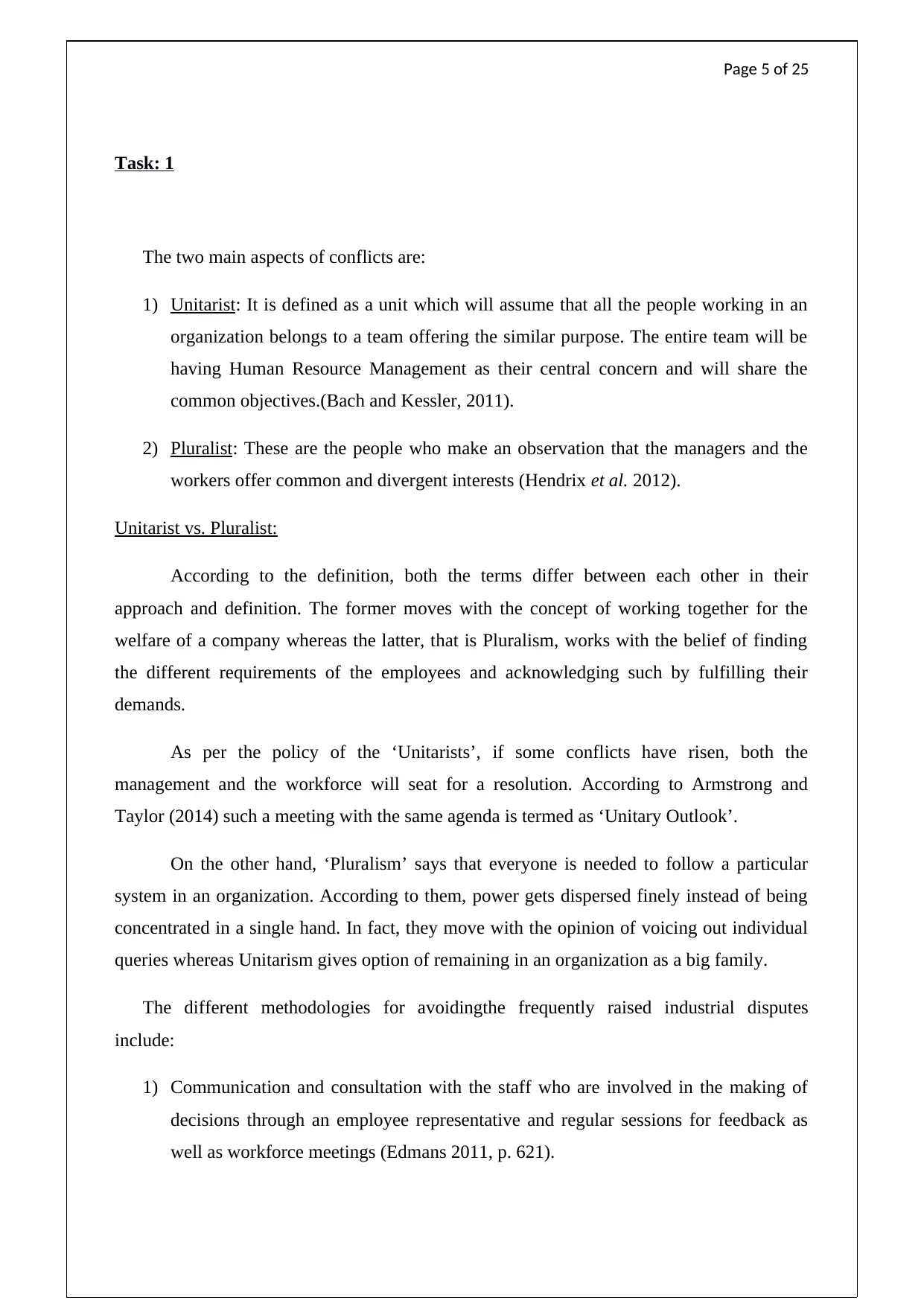
Page 5 of 25
Task: 1
The two main aspects of conflicts are:
1) Unitarist: It is defined as a unit which will assume that all the people working in an
organization belongs to a team offering the similar purpose. The entire team will be
having Human Resource Management as their central concern and will share the
common objectives.(Bach and Kessler, 2011).
2) Pluralist: These are the people who make an observation that the managers and the
workers offer common and divergent interests (Hendrix et al. 2012).
Unitarist vs. Pluralist:
According to the definition, both the terms differ between each other in their
approach and definition. The former moves with the concept of working together for the
welfare of a company whereas the latter, that is Pluralism, works with the belief of finding
the different requirements of the employees and acknowledging such by fulfilling their
demands.
As per the policy of the ‘Unitarists’, if some conflicts have risen, both the
management and the workforce will seat for a resolution. According to Armstrong and
Taylor (2014) such a meeting with the same agenda is termed as ‘Unitary Outlook’.
On the other hand, ‘Pluralism’ says that everyone is needed to follow a particular
system in an organization. According to them, power gets dispersed finely instead of being
concentrated in a single hand. In fact, they move with the opinion of voicing out individual
queries whereas Unitarism gives option of remaining in an organization as a big family.
The different methodologies for avoidingthe frequently raised industrial disputes
include:
1) Communication and consultation with the staff who are involved in the making of
decisions through an employee representative and regular sessions for feedback as
well as workforce meetings (Edmans 2011, p. 621).
Task: 1
The two main aspects of conflicts are:
1) Unitarist: It is defined as a unit which will assume that all the people working in an
organization belongs to a team offering the similar purpose. The entire team will be
having Human Resource Management as their central concern and will share the
common objectives.(Bach and Kessler, 2011).
2) Pluralist: These are the people who make an observation that the managers and the
workers offer common and divergent interests (Hendrix et al. 2012).
Unitarist vs. Pluralist:
According to the definition, both the terms differ between each other in their
approach and definition. The former moves with the concept of working together for the
welfare of a company whereas the latter, that is Pluralism, works with the belief of finding
the different requirements of the employees and acknowledging such by fulfilling their
demands.
As per the policy of the ‘Unitarists’, if some conflicts have risen, both the
management and the workforce will seat for a resolution. According to Armstrong and
Taylor (2014) such a meeting with the same agenda is termed as ‘Unitary Outlook’.
On the other hand, ‘Pluralism’ says that everyone is needed to follow a particular
system in an organization. According to them, power gets dispersed finely instead of being
concentrated in a single hand. In fact, they move with the opinion of voicing out individual
queries whereas Unitarism gives option of remaining in an organization as a big family.
The different methodologies for avoidingthe frequently raised industrial disputes
include:
1) Communication and consultation with the staff who are involved in the making of
decisions through an employee representative and regular sessions for feedback as
well as workforce meetings (Edmans 2011, p. 621).
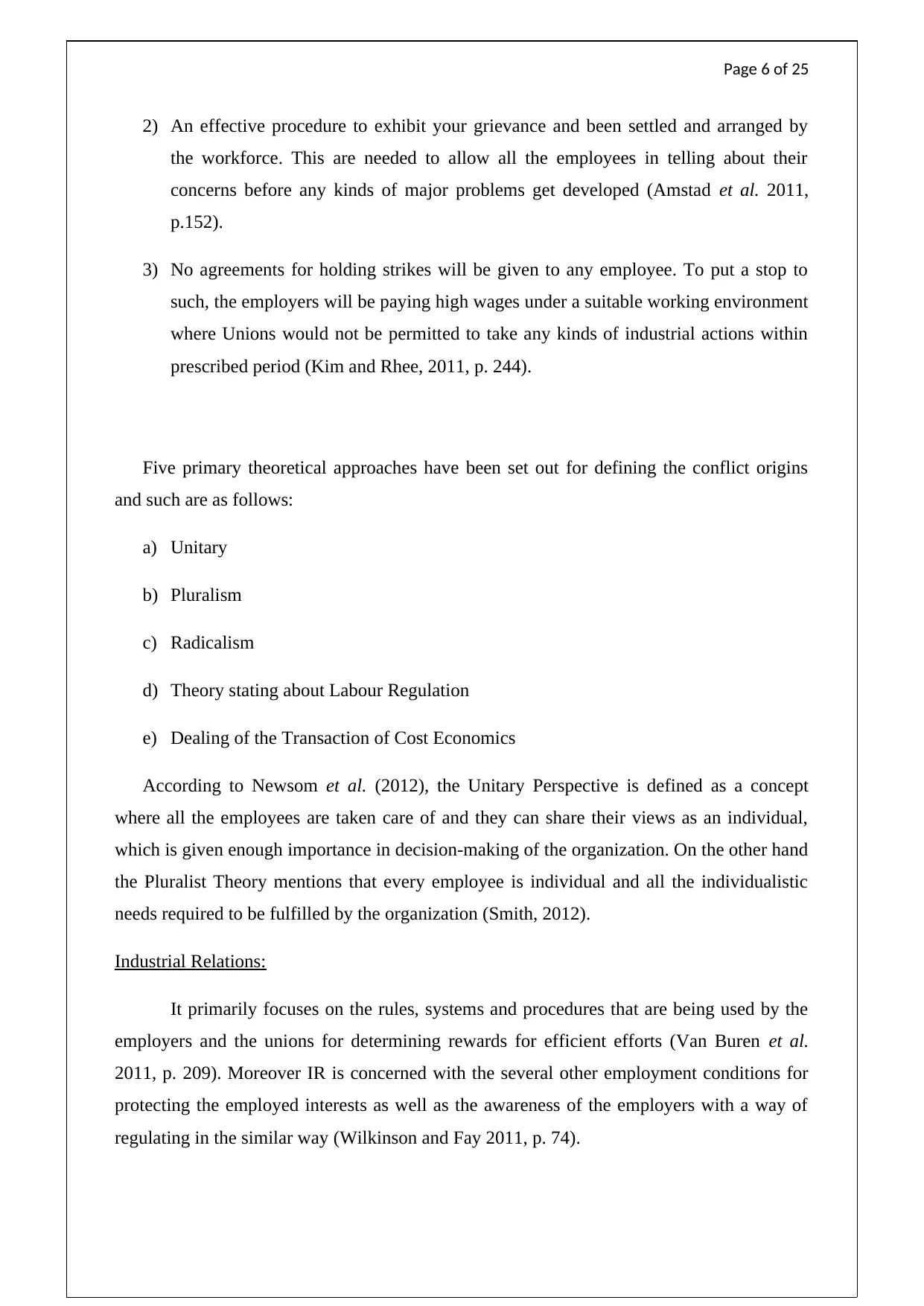
Page 6 of 25
2) An effective procedure to exhibit your grievance and been settled and arranged by
the workforce. This are needed to allow all the employees in telling about their
concerns before any kinds of major problems get developed (Amstad et al. 2011,
p.152).
3) No agreements for holding strikes will be given to any employee. To put a stop to
such, the employers will be paying high wages under a suitable working environment
where Unions would not be permitted to take any kinds of industrial actions within
prescribed period (Kim and Rhee, 2011, p. 244).
Five primary theoretical approaches have been set out for defining the conflict origins
and such are as follows:
a) Unitary
b) Pluralism
c) Radicalism
d) Theory stating about Labour Regulation
e) Dealing of the Transaction of Cost Economics
According to Newsom et al. (2012), the Unitary Perspective is defined as a concept
where all the employees are taken care of and they can share their views as an individual,
which is given enough importance in decision-making of the organization. On the other hand
the Pluralist Theory mentions that every employee is individual and all the individualistic
needs required to be fulfilled by the organization (Smith, 2012).
Industrial Relations:
It primarily focuses on the rules, systems and procedures that are being used by the
employers and the unions for determining rewards for efficient efforts (Van Buren et al.
2011, p. 209). Moreover IR is concerned with the several other employment conditions for
protecting the employed interests as well as the awareness of the employers with a way of
regulating in the similar way (Wilkinson and Fay 2011, p. 74).
2) An effective procedure to exhibit your grievance and been settled and arranged by
the workforce. This are needed to allow all the employees in telling about their
concerns before any kinds of major problems get developed (Amstad et al. 2011,
p.152).
3) No agreements for holding strikes will be given to any employee. To put a stop to
such, the employers will be paying high wages under a suitable working environment
where Unions would not be permitted to take any kinds of industrial actions within
prescribed period (Kim and Rhee, 2011, p. 244).
Five primary theoretical approaches have been set out for defining the conflict origins
and such are as follows:
a) Unitary
b) Pluralism
c) Radicalism
d) Theory stating about Labour Regulation
e) Dealing of the Transaction of Cost Economics
According to Newsom et al. (2012), the Unitary Perspective is defined as a concept
where all the employees are taken care of and they can share their views as an individual,
which is given enough importance in decision-making of the organization. On the other hand
the Pluralist Theory mentions that every employee is individual and all the individualistic
needs required to be fulfilled by the organization (Smith, 2012).
Industrial Relations:
It primarily focuses on the rules, systems and procedures that are being used by the
employers and the unions for determining rewards for efficient efforts (Van Buren et al.
2011, p. 209). Moreover IR is concerned with the several other employment conditions for
protecting the employed interests as well as the awareness of the employers with a way of
regulating in the similar way (Wilkinson and Fay 2011, p. 74).
⊘ This is a preview!⊘
Do you want full access?
Subscribe today to unlock all pages.

Trusted by 1+ million students worldwide
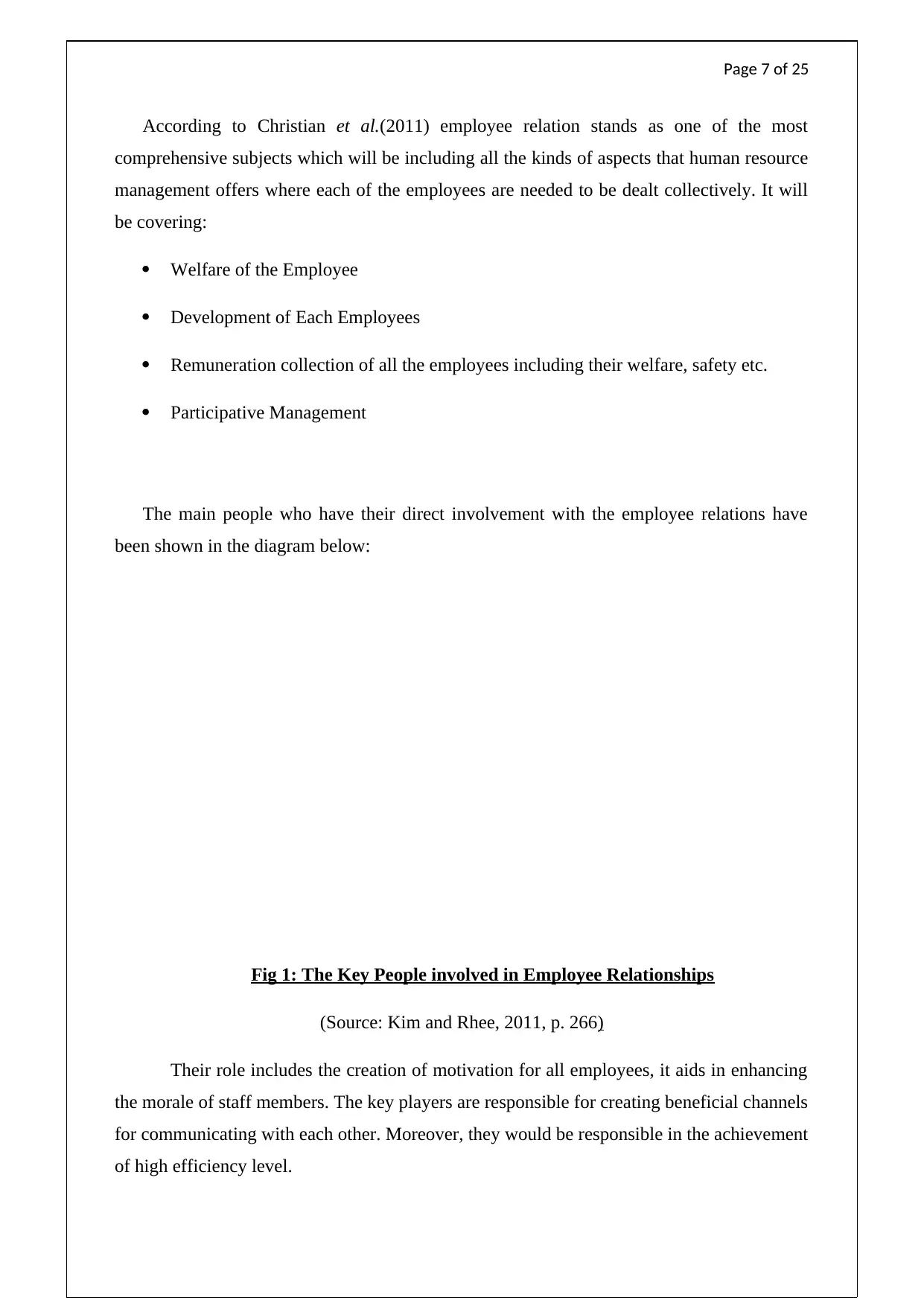
Page 7 of 25
According to Christian et al.(2011) employee relation stands as one of the most
comprehensive subjects which will be including all the kinds of aspects that human resource
management offers where each of the employees are needed to be dealt collectively. It will
be covering:
Welfare of the Employee
Development of Each Employees
Remuneration collection of all the employees including their welfare, safety etc.
Participative Management
The main people who have their direct involvement with the employee relations have
been shown in the diagram below:
Fig 1: The Key People involved in Employee Relationships
(Source: Kim and Rhee, 2011, p. 266)
Their role includes the creation of motivation for all employees, it aids in enhancing
the morale of staff members. The key players are responsible for creating beneficial channels
for communicating with each other. Moreover, they would be responsible in the achievement
of high efficiency level.
According to Christian et al.(2011) employee relation stands as one of the most
comprehensive subjects which will be including all the kinds of aspects that human resource
management offers where each of the employees are needed to be dealt collectively. It will
be covering:
Welfare of the Employee
Development of Each Employees
Remuneration collection of all the employees including their welfare, safety etc.
Participative Management
The main people who have their direct involvement with the employee relations have
been shown in the diagram below:
Fig 1: The Key People involved in Employee Relationships
(Source: Kim and Rhee, 2011, p. 266)
Their role includes the creation of motivation for all employees, it aids in enhancing
the morale of staff members. The key players are responsible for creating beneficial channels
for communicating with each other. Moreover, they would be responsible in the achievement
of high efficiency level.
Paraphrase This Document
Need a fresh take? Get an instant paraphrase of this document with our AI Paraphraser
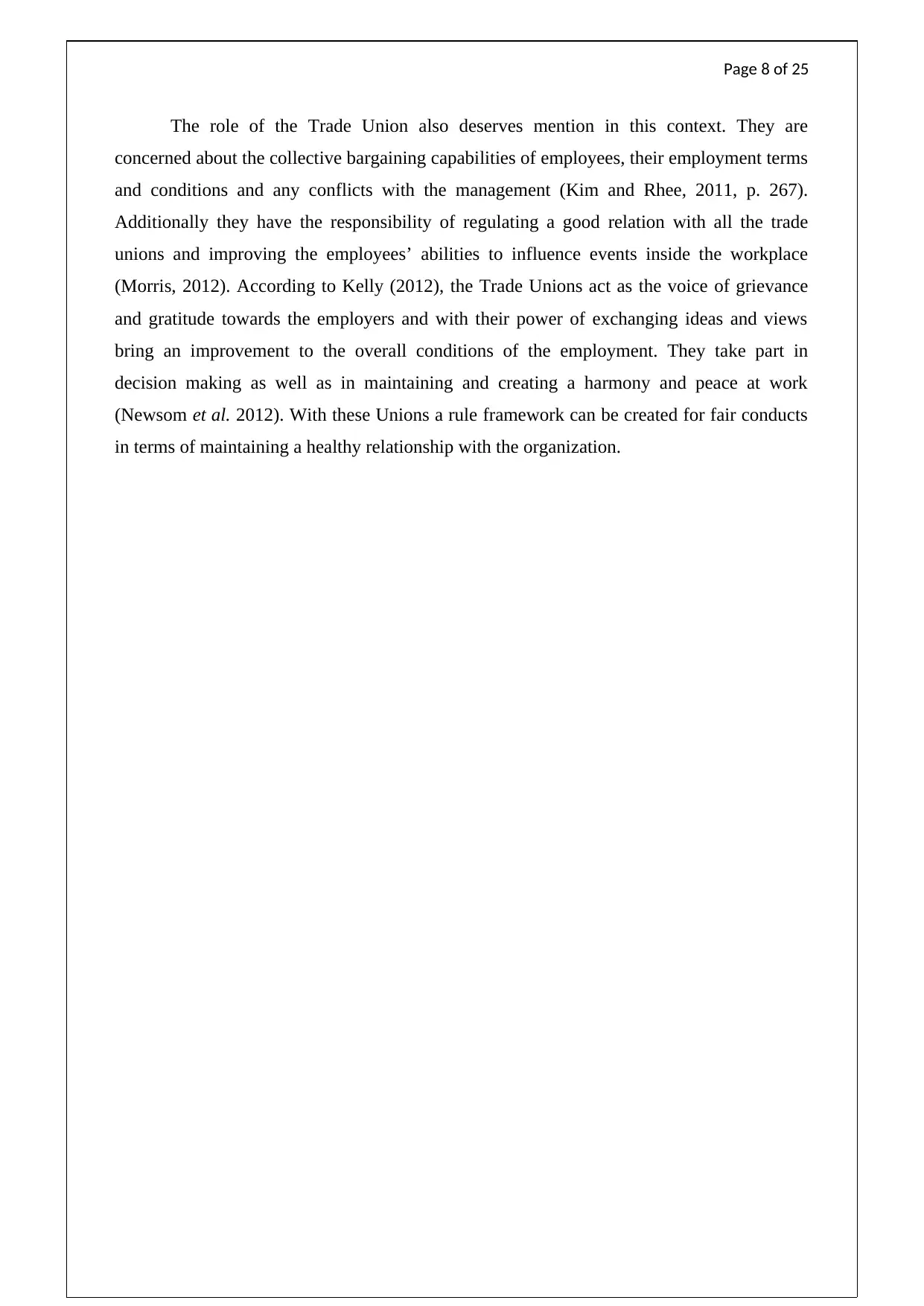
Page 8 of 25
The role of the Trade Union also deserves mention in this context. They are
concerned about the collective bargaining capabilities of employees, their employment terms
and conditions and any conflicts with the management (Kim and Rhee, 2011, p. 267).
Additionally they have the responsibility of regulating a good relation with all the trade
unions and improving the employees’ abilities to influence events inside the workplace
(Morris, 2012). According to Kelly (2012), the Trade Unions act as the voice of grievance
and gratitude towards the employers and with their power of exchanging ideas and views
bring an improvement to the overall conditions of the employment. They take part in
decision making as well as in maintaining and creating a harmony and peace at work
(Newsom et al. 2012). With these Unions a rule framework can be created for fair conducts
in terms of maintaining a healthy relationship with the organization.
The role of the Trade Union also deserves mention in this context. They are
concerned about the collective bargaining capabilities of employees, their employment terms
and conditions and any conflicts with the management (Kim and Rhee, 2011, p. 267).
Additionally they have the responsibility of regulating a good relation with all the trade
unions and improving the employees’ abilities to influence events inside the workplace
(Morris, 2012). According to Kelly (2012), the Trade Unions act as the voice of grievance
and gratitude towards the employers and with their power of exchanging ideas and views
bring an improvement to the overall conditions of the employment. They take part in
decision making as well as in maintaining and creating a harmony and peace at work
(Newsom et al. 2012). With these Unions a rule framework can be created for fair conducts
in terms of maintaining a healthy relationship with the organization.
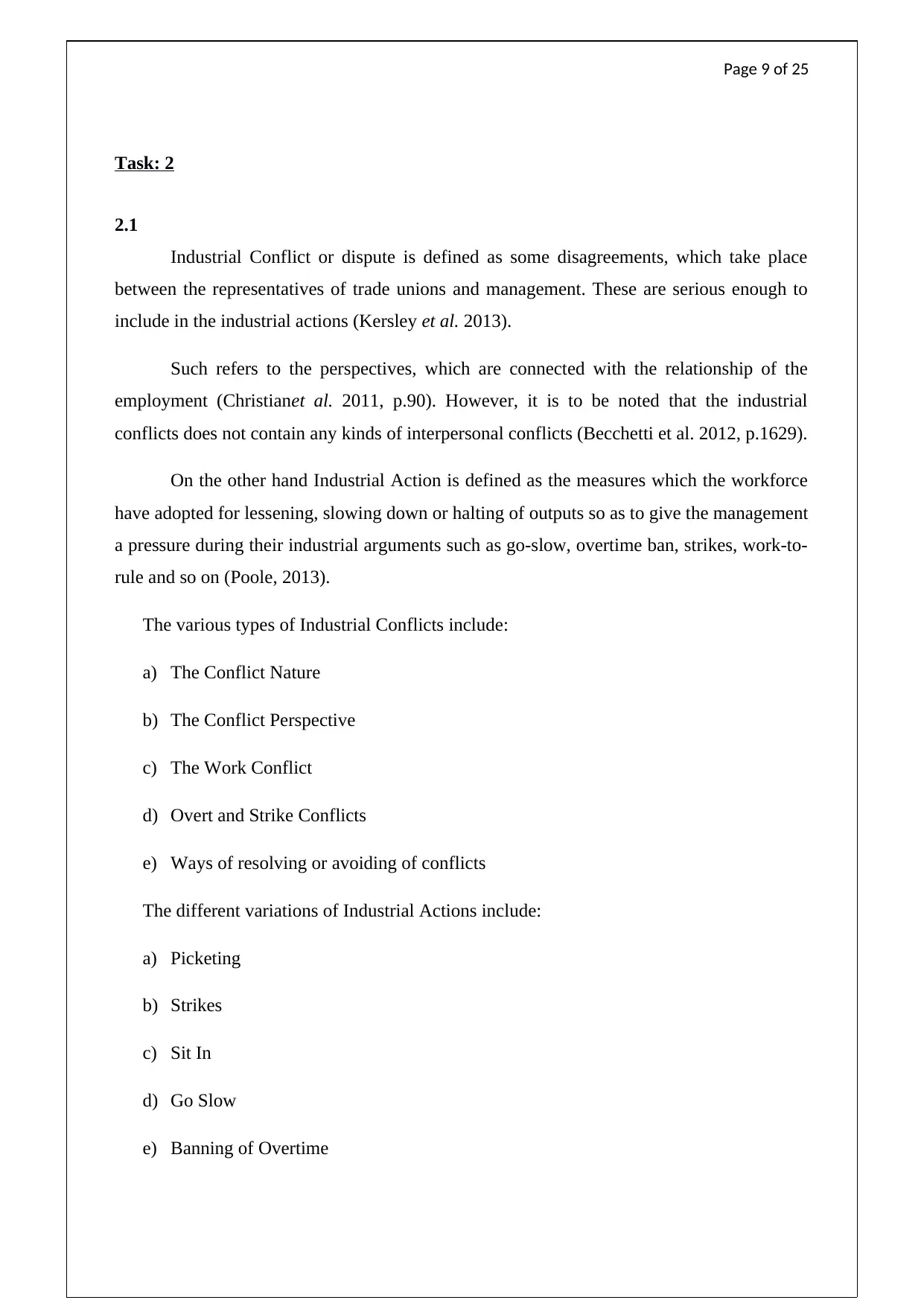
Page 9 of 25
Task: 2
2.1
Industrial Conflict or dispute is defined as some disagreements, which take place
between the representatives of trade unions and management. These are serious enough to
include in the industrial actions (Kersley et al. 2013).
Such refers to the perspectives, which are connected with the relationship of the
employment (Christianet al. 2011, p.90). However, it is to be noted that the industrial
conflicts does not contain any kinds of interpersonal conflicts (Becchetti et al. 2012, p.1629).
On the other hand Industrial Action is defined as the measures which the workforce
have adopted for lessening, slowing down or halting of outputs so as to give the management
a pressure during their industrial arguments such as go-slow, overtime ban, strikes, work-to-
rule and so on (Poole, 2013).
The various types of Industrial Conflicts include:
a) The Conflict Nature
b) The Conflict Perspective
c) The Work Conflict
d) Overt and Strike Conflicts
e) Ways of resolving or avoiding of conflicts
The different variations of Industrial Actions include:
a) Picketing
b) Strikes
c) Sit In
d) Go Slow
e) Banning of Overtime
Task: 2
2.1
Industrial Conflict or dispute is defined as some disagreements, which take place
between the representatives of trade unions and management. These are serious enough to
include in the industrial actions (Kersley et al. 2013).
Such refers to the perspectives, which are connected with the relationship of the
employment (Christianet al. 2011, p.90). However, it is to be noted that the industrial
conflicts does not contain any kinds of interpersonal conflicts (Becchetti et al. 2012, p.1629).
On the other hand Industrial Action is defined as the measures which the workforce
have adopted for lessening, slowing down or halting of outputs so as to give the management
a pressure during their industrial arguments such as go-slow, overtime ban, strikes, work-to-
rule and so on (Poole, 2013).
The various types of Industrial Conflicts include:
a) The Conflict Nature
b) The Conflict Perspective
c) The Work Conflict
d) Overt and Strike Conflicts
e) Ways of resolving or avoiding of conflicts
The different variations of Industrial Actions include:
a) Picketing
b) Strikes
c) Sit In
d) Go Slow
e) Banning of Overtime
⊘ This is a preview!⊘
Do you want full access?
Subscribe today to unlock all pages.

Trusted by 1+ million students worldwide
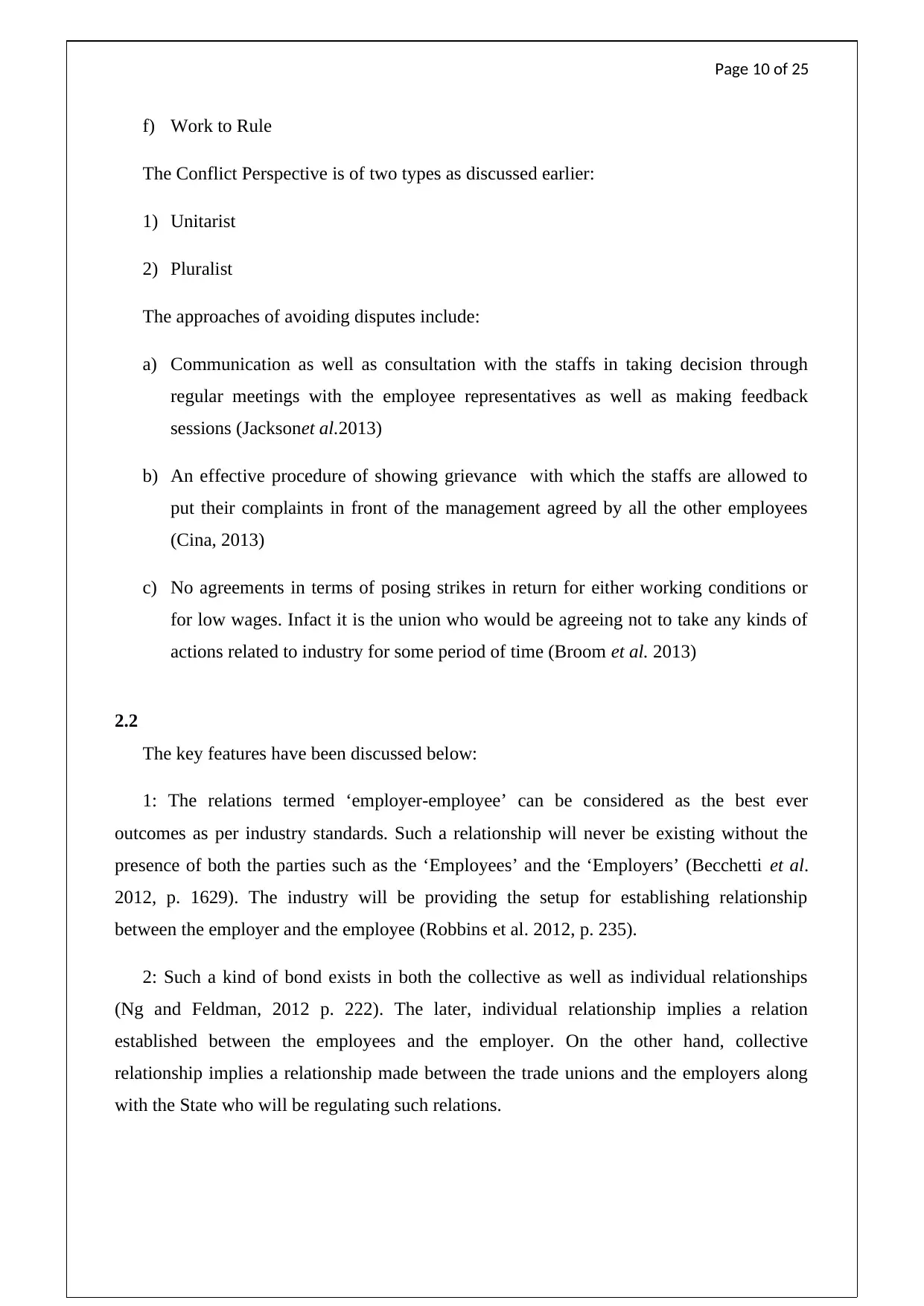
Page 10 of 25
f) Work to Rule
The Conflict Perspective is of two types as discussed earlier:
1) Unitarist
2) Pluralist
The approaches of avoiding disputes include:
a) Communication as well as consultation with the staffs in taking decision through
regular meetings with the employee representatives as well as making feedback
sessions (Jacksonet al.2013)
b) An effective procedure of showing grievance with which the staffs are allowed to
put their complaints in front of the management agreed by all the other employees
(Cina, 2013)
c) No agreements in terms of posing strikes in return for either working conditions or
for low wages. Infact it is the union who would be agreeing not to take any kinds of
actions related to industry for some period of time (Broom et al. 2013)
2.2
The key features have been discussed below:
1: The relations termed ‘employer-employee’ can be considered as the best ever
outcomes as per industry standards. Such a relationship will never be existing without the
presence of both the parties such as the ‘Employees’ and the ‘Employers’ (Becchetti et al.
2012, p. 1629). The industry will be providing the setup for establishing relationship
between the employer and the employee (Robbins et al. 2012, p. 235).
2: Such a kind of bond exists in both the collective as well as individual relationships
(Ng and Feldman, 2012 p. 222). The later, individual relationship implies a relation
established between the employees and the employer. On the other hand, collective
relationship implies a relationship made between the trade unions and the employers along
with the State who will be regulating such relations.
f) Work to Rule
The Conflict Perspective is of two types as discussed earlier:
1) Unitarist
2) Pluralist
The approaches of avoiding disputes include:
a) Communication as well as consultation with the staffs in taking decision through
regular meetings with the employee representatives as well as making feedback
sessions (Jacksonet al.2013)
b) An effective procedure of showing grievance with which the staffs are allowed to
put their complaints in front of the management agreed by all the other employees
(Cina, 2013)
c) No agreements in terms of posing strikes in return for either working conditions or
for low wages. Infact it is the union who would be agreeing not to take any kinds of
actions related to industry for some period of time (Broom et al. 2013)
2.2
The key features have been discussed below:
1: The relations termed ‘employer-employee’ can be considered as the best ever
outcomes as per industry standards. Such a relationship will never be existing without the
presence of both the parties such as the ‘Employees’ and the ‘Employers’ (Becchetti et al.
2012, p. 1629). The industry will be providing the setup for establishing relationship
between the employer and the employee (Robbins et al. 2012, p. 235).
2: Such a kind of bond exists in both the collective as well as individual relationships
(Ng and Feldman, 2012 p. 222). The later, individual relationship implies a relation
established between the employees and the employer. On the other hand, collective
relationship implies a relationship made between the trade unions and the employers along
with the State who will be regulating such relations.
Paraphrase This Document
Need a fresh take? Get an instant paraphrase of this document with our AI Paraphraser
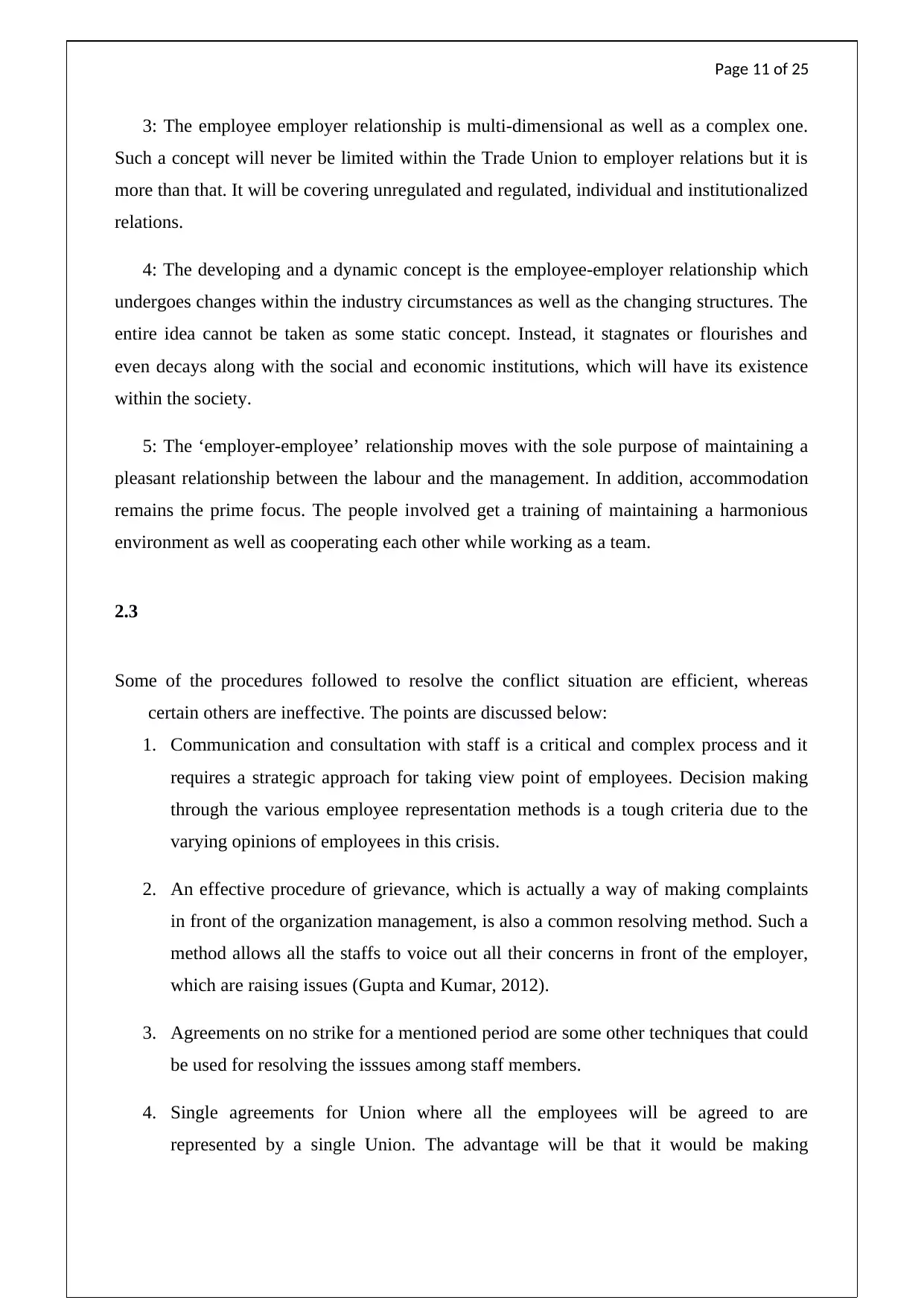
Page 11 of 25
3: The employee employer relationship is multi-dimensional as well as a complex one.
Such a concept will never be limited within the Trade Union to employer relations but it is
more than that. It will be covering unregulated and regulated, individual and institutionalized
relations.
4: The developing and a dynamic concept is the employee-employer relationship which
undergoes changes within the industry circumstances as well as the changing structures. The
entire idea cannot be taken as some static concept. Instead, it stagnates or flourishes and
even decays along with the social and economic institutions, which will have its existence
within the society.
5: The ‘employer-employee’ relationship moves with the sole purpose of maintaining a
pleasant relationship between the labour and the management. In addition, accommodation
remains the prime focus. The people involved get a training of maintaining a harmonious
environment as well as cooperating each other while working as a team.
2.3
Some of the procedures followed to resolve the conflict situation are efficient, whereas
certain others are ineffective. The points are discussed below:
1. Communication and consultation with staff is a critical and complex process and it
requires a strategic approach for taking view point of employees. Decision making
through the various employee representation methods is a tough criteria due to the
varying opinions of employees in this crisis.
2. An effective procedure of grievance, which is actually a way of making complaints
in front of the organization management, is also a common resolving method. Such a
method allows all the staffs to voice out all their concerns in front of the employer,
which are raising issues (Gupta and Kumar, 2012).
3. Agreements on no strike for a mentioned period are some other techniques that could
be used for resolving the isssues among staff members.
4. Single agreements for Union where all the employees will be agreed to are
represented by a single Union. The advantage will be that it would be making
3: The employee employer relationship is multi-dimensional as well as a complex one.
Such a concept will never be limited within the Trade Union to employer relations but it is
more than that. It will be covering unregulated and regulated, individual and institutionalized
relations.
4: The developing and a dynamic concept is the employee-employer relationship which
undergoes changes within the industry circumstances as well as the changing structures. The
entire idea cannot be taken as some static concept. Instead, it stagnates or flourishes and
even decays along with the social and economic institutions, which will have its existence
within the society.
5: The ‘employer-employee’ relationship moves with the sole purpose of maintaining a
pleasant relationship between the labour and the management. In addition, accommodation
remains the prime focus. The people involved get a training of maintaining a harmonious
environment as well as cooperating each other while working as a team.
2.3
Some of the procedures followed to resolve the conflict situation are efficient, whereas
certain others are ineffective. The points are discussed below:
1. Communication and consultation with staff is a critical and complex process and it
requires a strategic approach for taking view point of employees. Decision making
through the various employee representation methods is a tough criteria due to the
varying opinions of employees in this crisis.
2. An effective procedure of grievance, which is actually a way of making complaints
in front of the organization management, is also a common resolving method. Such a
method allows all the staffs to voice out all their concerns in front of the employer,
which are raising issues (Gupta and Kumar, 2012).
3. Agreements on no strike for a mentioned period are some other techniques that could
be used for resolving the isssues among staff members.
4. Single agreements for Union where all the employees will be agreed to are
represented by a single Union. The advantage will be that it would be making
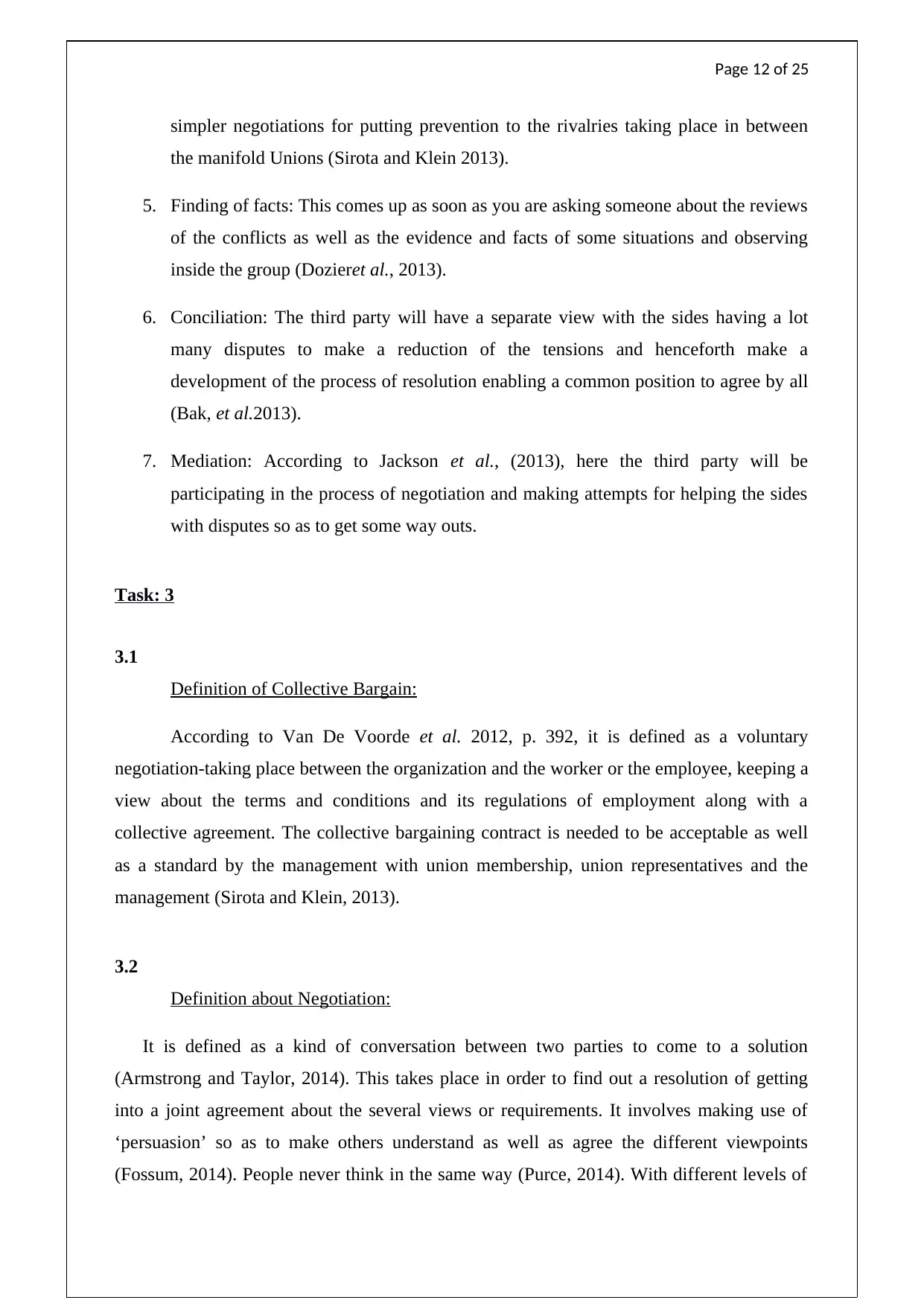
Page 12 of 25
simpler negotiations for putting prevention to the rivalries taking place in between
the manifold Unions (Sirota and Klein 2013).
5. Finding of facts: This comes up as soon as you are asking someone about the reviews
of the conflicts as well as the evidence and facts of some situations and observing
inside the group (Dozieret al., 2013).
6. Conciliation: The third party will have a separate view with the sides having a lot
many disputes to make a reduction of the tensions and henceforth make a
development of the process of resolution enabling a common position to agree by all
(Bak, et al.2013).
7. Mediation: According to Jackson et al., (2013), here the third party will be
participating in the process of negotiation and making attempts for helping the sides
with disputes so as to get some way outs.
Task: 3
3.1
Definition of Collective Bargain:
According to Van De Voorde et al. 2012, p. 392, it is defined as a voluntary
negotiation-taking place between the organization and the worker or the employee, keeping a
view about the terms and conditions and its regulations of employment along with a
collective agreement. The collective bargaining contract is needed to be acceptable as well
as a standard by the management with union membership, union representatives and the
management (Sirota and Klein, 2013).
3.2
Definition about Negotiation:
It is defined as a kind of conversation between two parties to come to a solution
(Armstrong and Taylor, 2014). This takes place in order to find out a resolution of getting
into a joint agreement about the several views or requirements. It involves making use of
‘persuasion’ so as to make others understand as well as agree the different viewpoints
(Fossum, 2014). People never think in the same way (Purce, 2014). With different levels of
simpler negotiations for putting prevention to the rivalries taking place in between
the manifold Unions (Sirota and Klein 2013).
5. Finding of facts: This comes up as soon as you are asking someone about the reviews
of the conflicts as well as the evidence and facts of some situations and observing
inside the group (Dozieret al., 2013).
6. Conciliation: The third party will have a separate view with the sides having a lot
many disputes to make a reduction of the tensions and henceforth make a
development of the process of resolution enabling a common position to agree by all
(Bak, et al.2013).
7. Mediation: According to Jackson et al., (2013), here the third party will be
participating in the process of negotiation and making attempts for helping the sides
with disputes so as to get some way outs.
Task: 3
3.1
Definition of Collective Bargain:
According to Van De Voorde et al. 2012, p. 392, it is defined as a voluntary
negotiation-taking place between the organization and the worker or the employee, keeping a
view about the terms and conditions and its regulations of employment along with a
collective agreement. The collective bargaining contract is needed to be acceptable as well
as a standard by the management with union membership, union representatives and the
management (Sirota and Klein, 2013).
3.2
Definition about Negotiation:
It is defined as a kind of conversation between two parties to come to a solution
(Armstrong and Taylor, 2014). This takes place in order to find out a resolution of getting
into a joint agreement about the several views or requirements. It involves making use of
‘persuasion’ so as to make others understand as well as agree the different viewpoints
(Fossum, 2014). People never think in the same way (Purce, 2014). With different levels of
⊘ This is a preview!⊘
Do you want full access?
Subscribe today to unlock all pages.

Trusted by 1+ million students worldwide
1 out of 25
Related Documents
Your All-in-One AI-Powered Toolkit for Academic Success.
+13062052269
info@desklib.com
Available 24*7 on WhatsApp / Email
![[object Object]](/_next/static/media/star-bottom.7253800d.svg)
Unlock your academic potential
Copyright © 2020–2025 A2Z Services. All Rights Reserved. Developed and managed by ZUCOL.





